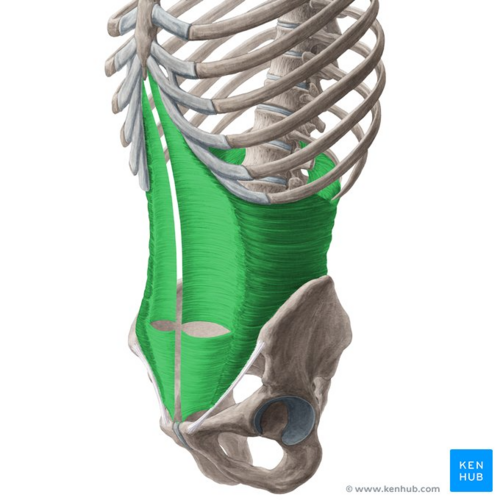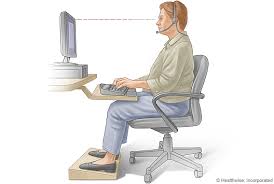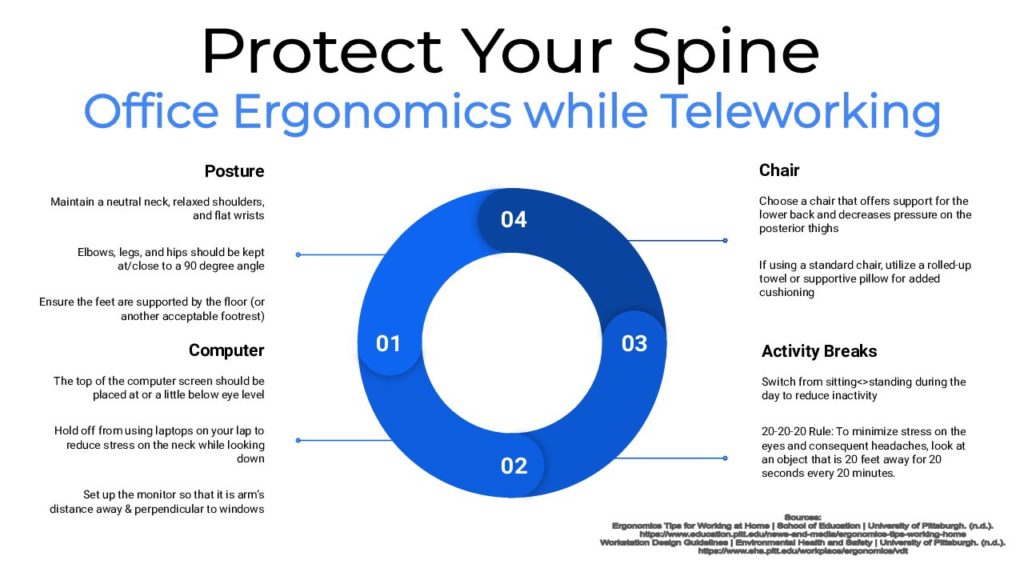
Uncategorized
Learn the Difference Between Physical Therapists and Chiropractors in the State of Maryland
Did you know that chiropractors can advertise they perform physical therapy in the state of Maryland? It can be very misleading so we will explain more below.
A Chiropractor can obtain what is called physical therapy privilege. They are allowed to advertise they perform physical therapy but not that they are a physical therapist. Therefore, you might see a place that is called Amazing Physical Therapy and Chiropractic Care. Don’t be fooled, you always want to ask what type of practitioners are on staff as it might just be Chiropractors. For a Chiropractor to get “physical therapy privilege”, they must get a minimum of 270 hours of physical therapy education from a chiropractic school.
A Physical Therapist goes to physical therapy school for 3 years and receives a doctorate degree in physical therapy. Then, they go on to pass a board examine in physical therapy to be licensed in the state. If you are looking for physical therapy services, make sure you do some research to determine what type of professionals you will be working with.
Diagnosing Neck Pain- What Is Upper Cross Syndrome?
Upper Cross Syndrome (UCS) is defined as a phenomenon that occurs as a result of muscle imbalance between your neck and shoulder muscles. UCS is the result of weak deep neck flexor muscles and mid back muscles as well as tight upper trap muscles and tight chest muscles. UCS often results in a rounded shoulder and forward head posture. UCS is fixed by strengthening the weak musculature and lengthening or stretching the tight musculature. Specifically, stretching out the pectorals, upper traps, and levator scapula muscles while also strengthening the deep neck flexors, lower traps, and serratus anterior muscles. Tools such as foam rollers and manual stretching may aid in lengthening the necessary musculature, while exercises such as chin tucks, serratus punches, and prone Ys may assist in strengthening the necessary muscles.
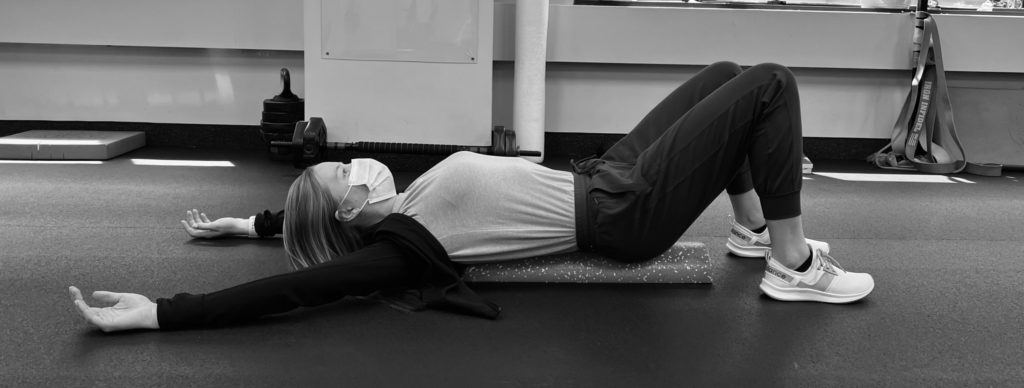
Benefits of Squatting
Squatting isn’t just for those really muscular people who put 700lbs on their back at the gym. In fact, I bet you don’t even realize how often you squat in a day. Think about the number of times you sit down on a chair and have to get back up, the number of times you go to the bathroom in a day, or even the amount of time you spend bending down to pick something up you might have dropped… This is constant, every-day squatting!
The squat is one of the most important exercises to perform for a wide variety of reasons. The squat aids in (1) increased leg strength, (2) increased core strength and lumbar stability, (3) increased hip and ankle mobility, (4) helps aid in the reduction of injury, and (5) increased metabolic rate due to muscle growth. Muscle loading the squat can be an effective way to increase muscle growth in the quadriceps, glutes, and hamstrings. Additionally, increased repetitions of squats with minimal muscle loading can enhance muscle endurance; this improves your ability to perform daily activities, increases athletic performance, and helps maintain improved posture/stability for extended periods of time.

Squatting below parallel does not increase your risk for knee injuries, however, it does often increase your risk for breaking proper squat form/mechanics. Squatting below parallel does not provide any significant muscle activation benefits, but can enhance mobility. Studies show minimal differences between squatting to 90 and squatting below 90. Most importantly, maintain good form and mechanics before progressing the depth of your squat – this will enhance overall benefits.
photo credit- santacruzcore.com
The Power of a Corset
In the early centuries, a corset was typically worn as a supportive undergarment that improved posture, supported the spine, and shaped the body into what was then called “ideal proportions.” While corsets used to come in many shapes, sizes, and colors – in today’s world the most important “corset” goes by a single name – the Transverse Abdominis (TrA).
The TrA is the deepest of the abdominal muscles and acts a girdle around the spine. The TrA responds most to perturbational movement and is the only abdominal muscle that remains activated with resisted extension in the spine (resisted extension often comes with exercises such as lifting a box incorrectly, deadlifts, and a quick jerking motion backwards). The TrA is the first stabilizer that kicks in with any arm/leg movements, and as a result helps limit your risk for injuries. It also aids in stabilizing each bone in your spine; so without this muscle, your spine would just be dancing around, pinching on nerves, and collapsing (almost).
The take home here is… the TrA is very important! You need this muscle to assist in stabilizing the spine and when it doesn’t do its job… you end up with back pain. The TrA is difficult to control. It doesn’t work like the 6-pack abs you’re used to. Try activating your TrA to reduce your risk of low back pain, improve your core and back stabilization, and reduce your risk for injury.
Why Should I Strengthen my Core?
Your core muscles are important for strength, balance, and overall function. Having a strong core helps to decrease the likelihood of developing back pain due to muscle compensation. There are many core exercises that can be performed in a variety of positions. You can even contract your core while performing any exercise of your choice to make the exercise into a core strengthening exercises.
Here is a core strengthening exercise you can perform anywhere to strengthen your core muscles.
- Assume a push-up position but bend your arms at your elbows so your weight rests on your forearms.
- Tighten your abs, clench your glutes and keep your body straight from head to heels.
- Start by holding the exercise for 10 seconds and build from there.
Make sure you are breathing while performing this exercise.
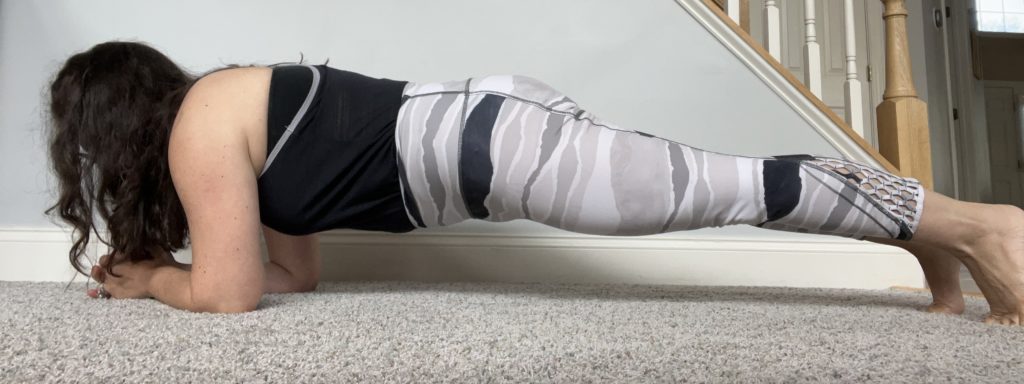
Stair Negotiation Physics
Many people with pain in the front of their knee comment that going down stairs is more challenging and painful than going up. Let’s take a quick look at why that is!
In the images below, Dr. Scott compares the forces at work when going up vs. down a step. The yellow arrow indicates the force of gravity and the green arrow is the force placed through the kneecap. A larger arrow = greater force, and as you can see the higher degree of knee bend when going down creates a higher force, and thus more stress, on the knee. This can cause increased pain and make descending steps quite challenging for those with a painful knee condition.
Written by Dr. Scott Newberry
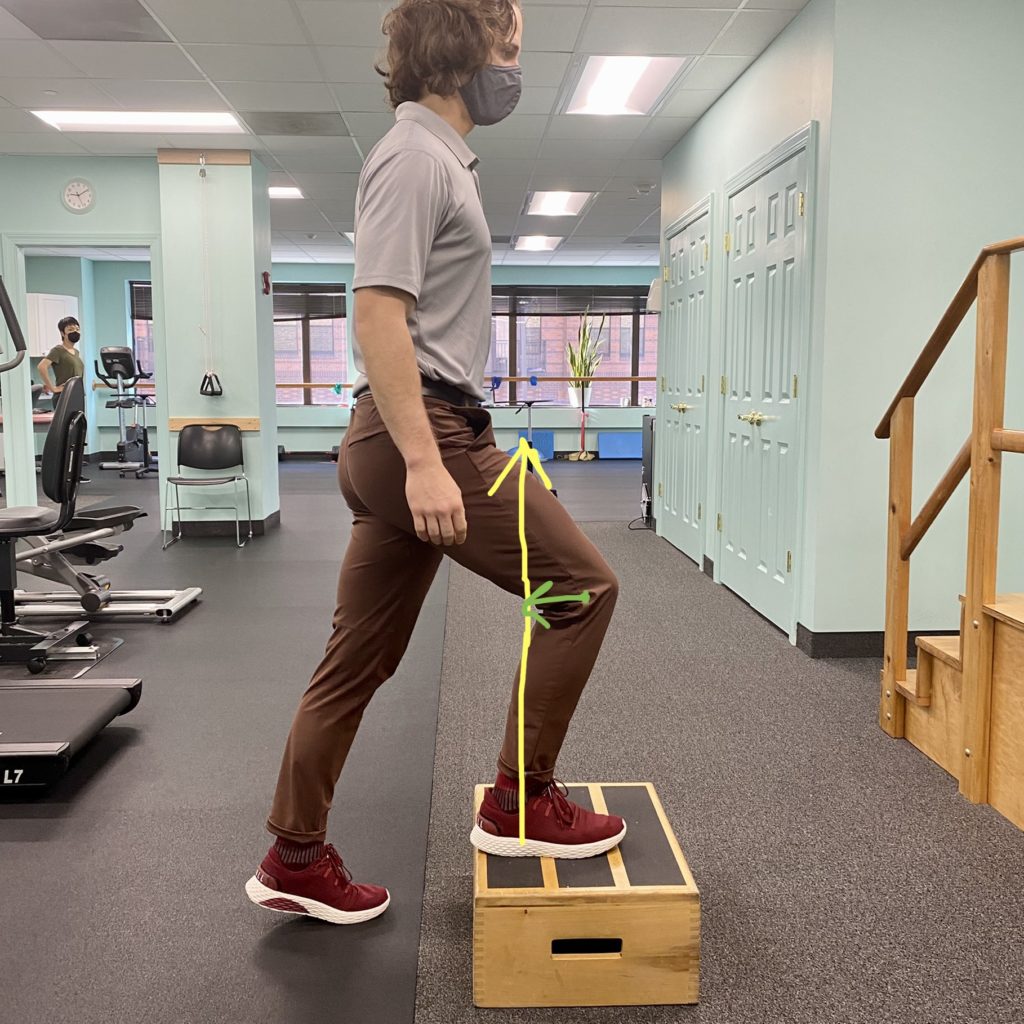
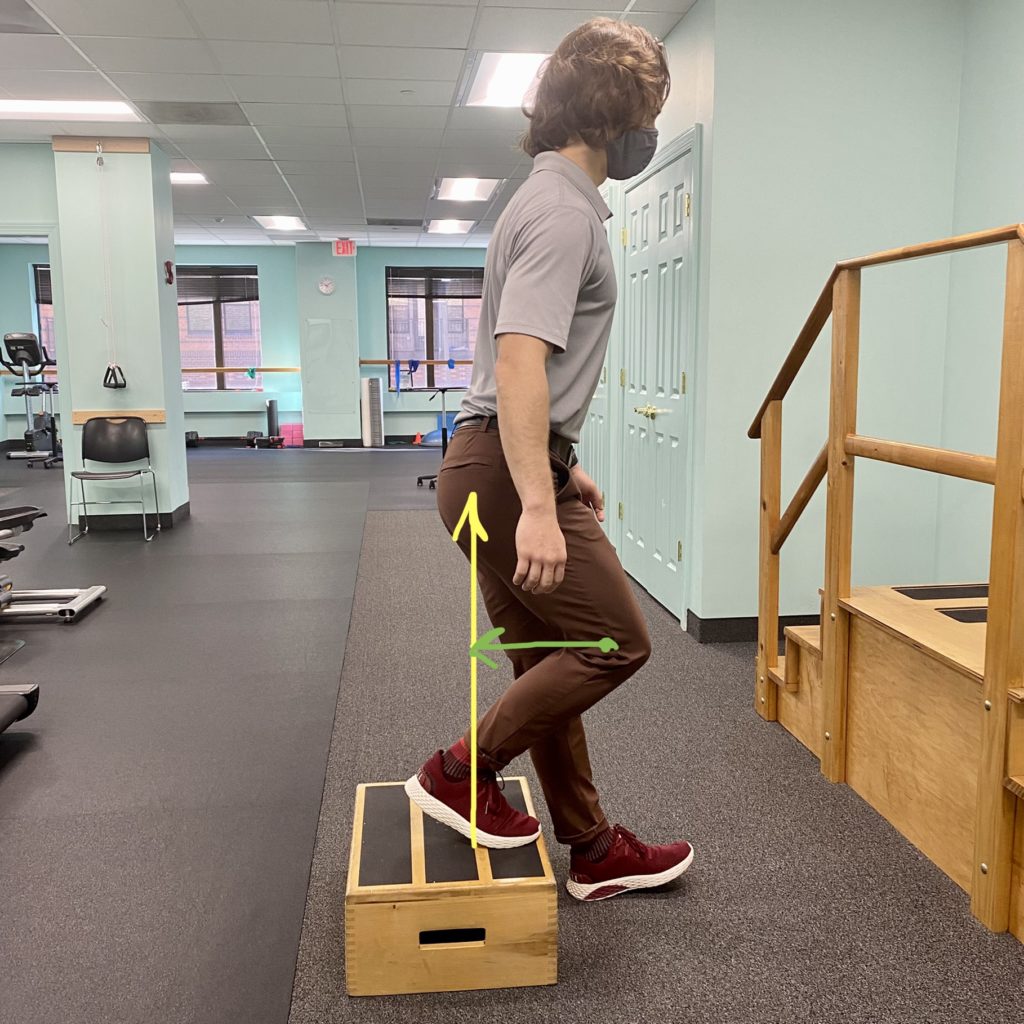
Yoga at Harbor Physical Therapy
Are you looking for local focused and personalized yoga classes? Harbor Physical Therapy offers Yoga and Chair Yoga weekly for only $15. All levels are welcome! Call 443-524-0442 to reserve your spot!
Check out these yoga flyers for more information:
How to Achieve an Ergonomic Workstation
1. Adjust your chair height so that your feet are flat on the floor. Use a footrest to assist.
2. Keep your wrist posture neutral.
3. Keep your monitor between 20 and 40 inches from your face.
4. Adjust your monitor so that the center of the screen is at eye level.
5. Place your keyboard so that your upper arms are perpendicular to the floor.
6. Adjust your chair to keep your body supported in an upright position.
7. Adjust your back rest to target the lumbar region of your spine.
8. Keep your work within 16 inches of your body.
If you are unable to achieve an ergonomic workstation on your own, Harbor Physical Therapy can help! Our Physical Therapists are able to assess your workstation sitting posture and transform it into an ideal sitting posture for your workstation to decrease strain on your joints.
The Real Weight of Obesity: What It’s Really Doing to Your Body
Obesity is a complex health disorder in which excess weight gain puts an individual at high risk for osteoarthritis and several life-threatening medical conditions. Although the obesity epidemic is currently affecting millions of Americans across the country, each person’s battle with obesity begins right at home with personal lifestyle choices.
Contributors to obesity include:
- Diet including intake of high-calorie foods
- Physical Inactivity
- Genetics (to an extent)
- Some illnesses
- Lack of sleep
- Certain medication use (such as steroids)
Effects of obesity may include (but are not limited to):
- High blood pressure
- Osteoarthritis – breakdown of cartilage between bones
- Diabetes
- Difficulty sleeping and breathing problems
- Heart disease
- Cancer
- Stroke
- Depression and social isolation
- Gallbladder disease
- Increased healthcare-related costs
Step-by-step on how to Fight Obesity:
- Drink lots of water! Keep your body hydrated throughout the day.
- Eat right! Fill your diet with whole grains, fruits and vegetables, and lean proteins; avoid foods with processed sugar and high animal fat content.
- Get active! Even a daily 10-minute walk can help. Challenge yourself by taking the stairs instead of the elevator.
- Stay active! The Physical Activity Guidelines for America recommends at least 2.5 hours of moderate aerobic activity or 75 minutes of vigorous activity per week to stay heart healthy and to add 2 additional days of strength training.
- Stay motivated! Find friends or family to share your experience with. Weight loss is a marathon not a sprint, losing 1-2 pounds per week is a healthy pace.
**Remember!! Every pound lost is a success! Small amounts of weight loss have been shown to have substantial benefits including reducing knee and hip pain from arthritis, increasing blood flow through the body and heart, and improving overall quality of life!

